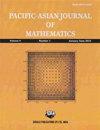Origamis associated to minimally intersecting filling pairs
IF 0.7
3区 数学
Q2 MATHEMATICS
引用次数: 3
Abstract
Let $S_{g}$ denote the closed orientable surface of genus $g$. In joint work with Huang, the first author constructed exponentially-many (in $g$) mapping class group orbits of pairs of simple closed curves whose complement is a single topological disk. Using different techniques, we improve on this result by constructing factorially-many (again in $g$) such orbits. These new orbits are chosen so that the absolute value of the algebraic intersection number is equal to the geometric intersection number, implying that each pair naturally gives rise to an origami. We collect some rudimentary experimental data on the corresponding $SL(2, \mathbb{Z})$-orbits and suggest further study and conjectures.与最小相交填充对相关的Origamis
设$S_{g}$表示亏格$g$的闭可定向曲面。在与黄的合作中,第一作者构造了补为单个拓扑盘的简单闭曲线对的指数多映射类群轨道。使用不同的技术,我们通过构建因子多个(同样是$g$)这样的轨道来改进这一结果。选择这些新的轨道是为了使代数交集的绝对值等于几何交集,这意味着每对轨道自然会产生折纸。我们收集了一些关于相应的$SL(2,\mathbb{Z})$-轨道的初步实验数据,并提出了进一步的研究和猜测。
本文章由计算机程序翻译,如有差异,请以英文原文为准。
求助全文
约1分钟内获得全文
求助全文
来源期刊
CiteScore
1.30
自引率
0.00%
发文量
93
审稿时长
4-8 weeks
期刊介绍:
Founded in 1951, PJM has published mathematics research for more than 60 years. PJM is run by mathematicians from the Pacific Rim. PJM aims to publish high-quality articles in all branches of mathematics, at low cost to libraries and individuals. The Pacific Journal of Mathematics is incorporated as a 501(c)(3) California nonprofit.

 求助内容:
求助内容: 应助结果提醒方式:
应助结果提醒方式:


